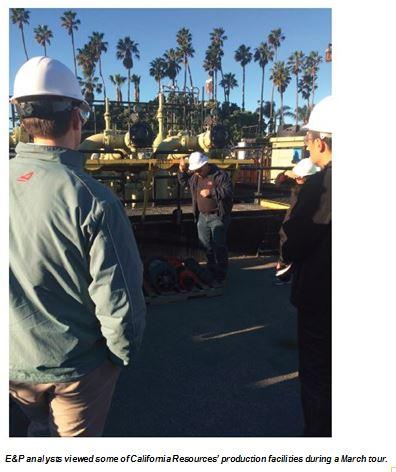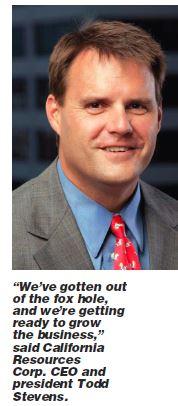
For all of the hullabaloo coming out of the Permian Basin and Oklahoma these days, one might forget that California produces a lot of crude oil and natural gas and has vast resources still to be tapped, even though it’s been producing oil since 1876. Kern County alone ranks among the top two or three counties in the U.S. for crude oil output. True, the downturn hit the Golden State hard and drilling activity declined. But now, some big money has not overlooked the state, perhaps thinking deals elsewhere have gotten too pricey.
The key to success in California is navigating the state’s complex regulatory climate and knowing how to apply the right technology to improve recoveries from its mostly shallow, heavy-oil reservoirs. California crude trades about $3 per barrel (bbl) below $50 oil on Nymex, but the economics are such that some heavy oil production can yield rates of return of 50% and more.

Some recent transactions show that California still attracts companies and capital. In late 2016, private equity firm Quantum Energy Partners staked a new portfolio company, Denver-based Sentinel Peak Resources LLC, in partnership with a seasoned team. Michael Duginski was previously the COO of Berry Petroleum Co., an active California independent; and George Ciotti and Tim Crawford were also on Berry’s leadership team. Each is well-versed in California’s unique operational climate with about 30 years’ experience.
In December, Sentinel Peak paid $592 million to acquire Freeport-McMoRan Oil & Gas LLC’s California onshore assets. At one time before the bust, they had been valued at 10x that amount.
Earlier this year, Benefit Street Partners formed a drilling joint venture (JV) DrillCo with publicly held California Resources Corp. (CRC), agreeing to advance tranches of $50 million periodically over the next two years, up to $250 million total, so that CRC can capitalize on its substantial undeveloped inventory. The latter has set a budget this year of $300 million, not including the capital in the DrillCo, vs. a budget that fell to nearly zero during the depths of the downturn.
Principals from both capital providers cited some unique, attractive aspects of doing business in California. For one, there aren’t as many buyers or companies to compete against—then too, there isn’t that much acreage freed up to buy in the first place (most is tightly held by majors or small-cap private companies). Another pro: the untapped resource opportunities in the state remain very large.

The Freeport-McMoRan assets that Sentinel Peak acquired were one of the few sizable packages available, with 28,000 bbl/d of oil production in the San Joaquin and Los Angeles basins. “This is a unique, out-of-the-box situation—you don’t get too many shots on goal like this, to own world-class legacy assets such as these,” said D Verma, president of Houston-based Quantum Energy Partners.
“There are an enormous amount of redevelopment opportunities in California and on these properties in particular,” he said. “We definitely intend to invest significant capital into this in the next few years. A lot of new hiring and budgeting is going on right now.”
Sentinel Peak and Quantum worked together with Freeport Oil & Gas’s team for many months to craft a specific plan that would help them achieve their near-term objectives, but also allow them additional upside over time, he added. Under Freeport-McMoRan’s ownership, the assets hadn’t been a top priority for spending, as it had bigger plans for its Gulf of Mexico and international assets, some of which have since been sold. In 2013, when these assets were acquired by Freeport from Plains Exploration & Production Co., they were given a value north of $5 billion, yet Sentinel Peak Resources acquired them for $592 million plus a contingency fee.
According to CEO Duginski, there are some 5 billion bbl of original oil in place, yet the typical recovery factor is only about 30%, so the long-term potential is high. “We’re looking to get 50% to 70% recovery in some areas,” he said.
The stars have to align for any buyer in California, because people are wary of the regulatory environment, which serves as a barrier to entry for most. The key for Quantum’s involvement was to team up with partners who have strong regulatory and operational expertise there, “and that’s truly a short list,” Verma said. Duginski fit the bill, however, being the former COO of Berry Petroleum before it was acquired by Linn Energy.
Quantum was in touch with him and other former Berry executives off and on from 2014 until Sentinel Peak’s formation in 2016, exploring ideas and looking at opportunities together, Verma said. Meanwhile, after Berry was sold, Duginski and CFO George Ciotti spent nearly a year meeting with various private equity providers before linking up with Quantum.
Now, Sentinel Peak intends to pursue projects across its new asset base and consider further acquisitions as well, Duginski said. “It’s a little early to be talking about budgets until we get the technical work done,” he said.
“We are going to spend $50- to $100 million this year, but that’s the tip of the iceberg as to what the future development plans are.
“We’re doing a full reservoir study now using existing data to lay out a full-life depletion plan for the assets, and we’ll be using both steam flood and cyclic steam operations for the heavy-oil assets, as well as water-flood optimization for the light oil fields. We’re looking at what’s most economic and what’s the appropriate technology.”

CRC’s new benefit
CRC, being a much larger entity, historically didn’t have to worry much about sourcing capital because it was part of a well-funded and even larger parent, Occidental Petroleum Corp. However, with its 2014 spinoff, all that changed—especially as Oxy transferred $6 billion of debt to CRC at the time. Then the downturn hit, forcing CRC against the ropes: it stopped drilling in 2016 and focused instead on protecting base production, building inventory and living within cash flow. It also worked hard on the over-burdened balance sheet—it has already reduced the debt by $1.5 billion.
Nevertheless, the company has a lot of work to do on the drilling and production side. “It is beneficial for us to partner with sophisticated investors to enable us to accelerate our value,” said president and CEO Todd Stevens of the Benefit Street deal.
“With our extensive inventory, we feel these drilling JVs are a good way to go. We think the JV with Benefit Street will bring in $50- to $150 million this year, probably for activity in the San Joaquin Basin first.” In March, it had three rigs drilling there, vs. none a year earlier.
“We’re getting out of the fox hole and getting ready to grow again,” said Stevens.
In aggregate, CRC will drill about 175 to 200 wells throughout the state, including with the JV money, and including producers and injection wells needed for water floods and steam floods.
“California is kind of an island, the land that time forgot because people are so caught up in the shales,” Stevens said. “But this is the ‘Permian Basin,’ with tectonics. It’s full of stacked pays—there’s never been a well drilled by us in the state that didn’t encounter hydrocarbons.”
This bounty makes the additional drilling capital all the more important. “Benefit Street just made sense—we already knew them and started talking to them last year,” Stevens said. “In the past, we had often been pursued by people interested in California, but we sort of pushed them away because of our parent company. We had been close to doing one of these JVs after the spinoff though, but then the macro environment caused us to slam on the brakes.”
Stevens said as things have evolved over time, talks are underway with several parties about additional JVs. “We’re looking to do more,” he said.
“We are resource-rich and our inventory is growing, but do have balance sheet issues, and plus, we do have a real commitment to live within cash flow. This is not a shale-driven model, but we do have shale-type opportunities. We really are a conventional business: we have every type of drive mechanism and every type of hydrocarbon product you might dream of,” Stevens told E&P analysts during their field trip in March to the company’s flagship property, Elk Hills Field, one of the largest oil fields in the U.S.
A CRC discovery near there in 2010, called Gunslinger, proved the point that as old as California’s oil and gas industry is, there is much more work to do, especially by applying 3-D seismic and more modern completions.
Coming full circle, Petrie Partners helped tee up the deal between CRC and Benefit Street, which made sense. (When it was known as Petrie Parkman & Co. in 1997, it handled the U.S. government’s sale of Elk Hills, which was a Naval Petroleum Reserve, for $3.7 billion. At the time, it was one of the largest energy divestments in decades.) More recently, Petrie’s Mike Bock had contacted Benefit Street to say that CRC was looking for development capital.

California’s appeal?
Most investors have viewed California warily for several reasons. Basins like the Permian, for example, garner so much more deal flow because there are literally dozens of public and private E&P companies from which to analyze the comps on asset values, and from which to pick up interests in hundreds of wells. However, California is like a different universe, people say. It is highly concentrated, with most of the properties, some 85%, still in the hands of just a handful of E&P companies, and most of them are super majors.
“It’s hard for people to understand California,” said Stevens. “From a public company standpoint, there aren’t any comparables, so that affects investors’ understanding of us. As the largest private mineral owner in the state, we are like a major company with opportunities across multiple basins and multiple horizons, blessed with great assets, but with the balance sheet of a very levered independent.”
There is a compelling reason to keep drilling in the state, Stevens said. California is burdened with importing about 64% of its crude oil from Alaska and other international sources, and more than 90% of its natural gas from outside the state. Increasing California production is important to lessen that burden.
To that end, CRC plans to run five to seven rigs this year, drill a few exploration wells and bring another JV across the finish line, Stevens said.
To operate within economic guidelines, the company has created a value creation index that demands for every dollar spent, CRC has to make back at least $1.30 of PV-10. “We were well in excess of that last year,” Stevens said.
A long-life play
Negative perceptions about the state, or low commodity prices, did not deter Benefit Street’s Tim Murray. “Two years ago when the CEO asked me, ‘Where should we invest?’ my answer was long-life oil. If you play in long-life oil, and yet you’re in the midst of a terrible oil price downturn, a year or two is a moment in time,” he said.
California is a long-term play that’s perfect for Benefit Street’s long-term focus. Kern County alone is the second-highest oil producing county in the Lower 48, even though it gets overshadowed by headlines from the Bakken Shale or the Permian Basin.
“The most exciting thing about California is that it’s one of the largest resource areas in the U.S., if not the world,” Murray said. “It’s an area that’s been kind of out of favor, but if you partner with the best folks out there—and no one would argue that it’s not CRC—it’s a win-win. They just needed some additional capital with creativity around the structure.”
Another reason Murray is sanguine? He was formerly the head of Wells Fargo Energy Capital, who is very familiar with California. At Wells Fargo he made some of the initial loans to several California operators there, including Breitburn Energy Partners and Venoco. The bank was the longtime lead lender to Berry Petroleum before it was acquired in 2013 by Linn Energy for $4.9 billion. (Since Linn Energy emerged from bankruptcy this spring, Benefit Street has become a major shareholder in the “new Berry,” which was separated from Linn as part of the bankruptcy restructuring agreement.)
Murray said Benefit Street devised “a fairly unique structure” for CRC that works well for all parties and addresses the challenges associated with helping to fund a levered E&P company bound by various bank covenants, without contravening existing documents. “It was like deciphering a puzzle,” Murray said.
Interests in wells drilled by the JV revert back to CRC once Benefit Street realizes its targeted rate of return in the lower teens. The JV will be modestly cash-flow positive to CRC in the second half, Stevens told analysts.
“We’d be pretty excited to help them out further if the opportunity presents itself,” Murray said. “They have hundreds of conventional opportunities for light oil and condensate throughout the state, and a lot of it is fairly shallow, 7,500 to 15,000 feet, that in many cases hasn’t been touched. What’s more, CRC has the benefit of all the 3-D seismic that Oxy had shot and here you really need seismic because the subsurface is so complex.”
It’s an old truism that complexity in the oil patch usually means caution for many, scares away others, and yet, big opportunity for a few. Some savvy capital providers are looking at California anew, for just that reason.
Recommended Reading
Energy-Focused AI Platform Collide Closes $5MM Seed Round
2025-04-15 - The $5 million seed round was led by Mercury Fund, with participation from industry veterans Bryan Sheffield and Billy Quinn, among others.
Vaquero Scales Up Credit Facility to Fund Project Expansions
2025-04-15 - Vaquero Midstream has closed on an increased credit facility to help fund system expansions the company has planned for 2025 and 2026.
Former LM Energy Team Creates Mora Energy, Backed by NGP and Old Ironsides
2025-04-14 - The management team of newly formed Mora Energy is starting with more than $250 million in equity commitments to pursue new energy infrastructure opportunities.
APA Updates Leadership, Names Ben Rodgers as EVP, CFO
2025-04-14 - APA Corp. is making several leadership changes, including appointing Khalda Petroleum board director Ben Rodgers as executive vice president and CFO.
USD Completes Final Asset Sale of Hardisty Terminal
2025-04-13 - USD Partners was obligated to sell the Hardisty Terminal, in Alberta, Canada, after entering a forbearance agreement with its lenders on June 21 2024.
Comments
Add new comment
This conversation is moderated according to Hart Energy community rules. Please read the rules before joining the discussion. If you’re experiencing any technical problems, please contact our customer care team.





